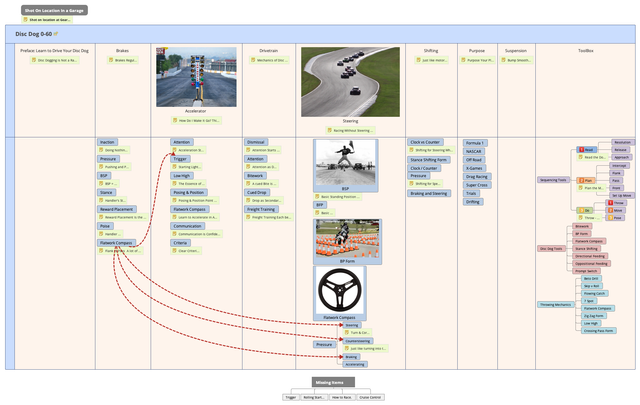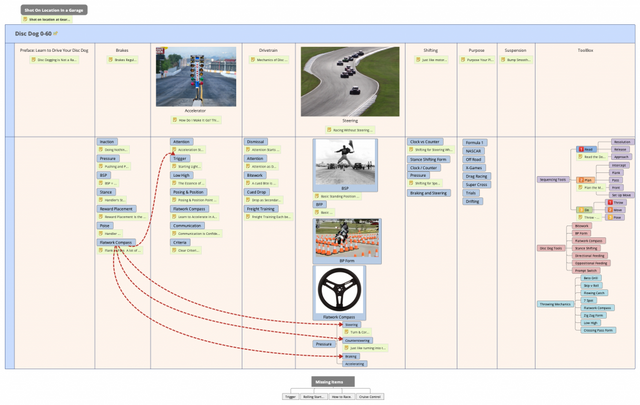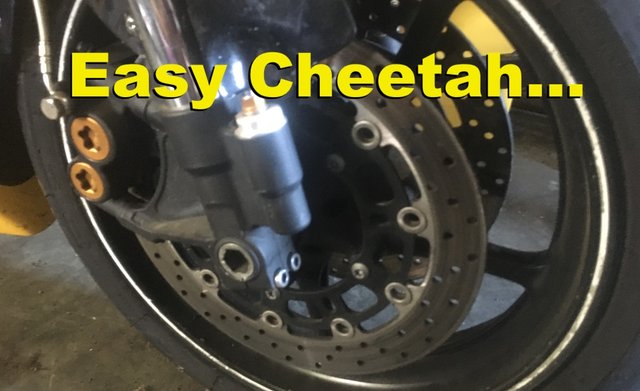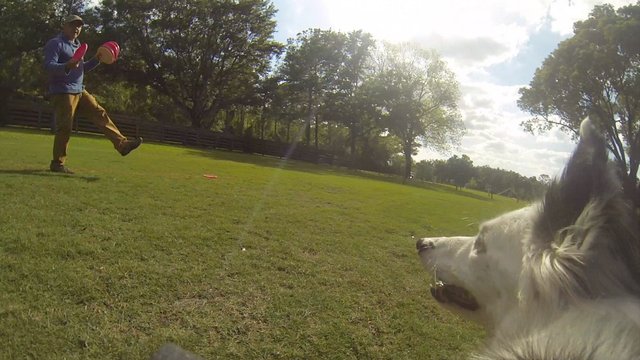Script & Companion Text Sample from Disc Dog 0-60 - How to Effectively Drive Your Disc Dog


A mindmap of the project. This mindmap serves as a production script and will be cleaned up and turned into a companion text piece (PDF).
Here are a couple of excerpts from the Disc Dog 0-60 - How to Effectively Drive Your Disc Dog.
This is part of my script and will be dressed up as companion text to the video.
There are still a few pre-orders left. I'm thinking it might go up in price, but won't make a decision on that until the project is nearly done.
Here's a link to the product page. Get in while the gettin's good...
Section 1: Brakes
Brakes Regulate Speed and Control

In order to go, you must first be stopped. Having functional brakes on your dog is every bit as important as having brakes on your race car. The better and more highly tuned the brakes, the faster and more precise and purposeful you can be on the track. With highly tuned brakes the team can go harder and faster into corners, making sharper and more predictable lines and maneuvers.
Section 1.1: Inaction
Doing Nothing = Brakes
If the dog goes, don't throw.
It is impossible for a dog to play too fast. The dog will play at the speed the handler lets him.
Doing nothing should be the first option by both dog and handler if there is any question as to what is happening. You don't go if you don't know where you're going, and, no, "going fast" is not a place.
No Throw = Stalk
If there is no target there is nothing to strike. If there is nothing to strike, a dog will stalk the target in order to activate it.
It's like a yellow flag on the race track. Nothing's going to happen but the bare minimum of the race - we'll just hold our positions until it's time to start racing again.
Section 1.5 - Reward Placement
The Catch Is the Finish Line
If we look at the race as the moment the target is presented to where it is caught, then we can see that the catch can be seen as the finish line.
If the object is to get to the finish line, like NOW, like it is for most dogs, then reward placement is going to have great bearing on speed and distance of the race.
If the dog wants to run far and run fast, think about your reward placement? Where is it at? When is it at?
If you want the dog to run slower, slow down, or stop, leverage reward placement to change the finish line. Change the location and timing of the finish line and you change the pace of the race.
Trying to stop or slow down a dog with the same old reward placement can be nearly impossible.
Section 2 - Accelerator
How Do I Make It Go?

This is a question both dog and handler should ask, but most of the time we're too busy manning the wheel and frantically pumping the pedals that we've gone way past that stage. Let's slow down a minute and examine what's really going on when we hit the gas on our disc dog.
Christmas Tree (starting lights)
Verbal - Staging Light | Physical - Yellow | Target - Green
You hit the gas, committing to GO during the yellow light - a little more than 1/2 a second before the light turns green. If you do that, the linkage of the vehicle and human response time add up to equal Go at the proper time. There is actually a bit of a science to a great reaction time on the drag strip.
The Christmas tree lights are set up to create a rhythm and timing that the skillful driver can rely on to deliver a responsive, well timed start.
Our cuing system should serve similar function.
Staging Light = Lined Up
The Staging lights are on top. They are the lights to let the driver know that they are in position and a start is on.
There should be a default staging behavior with a clear mark, signal, or cue.
Yellow Light = Trigger
Once your staging light is all set, then you're ready to race. The Yellow light will give you the physical timing to hit the gas at the right time to have a successful start.
The Yellow Light is the Trigger for commitment. It is most likely NOT your chosen cue, or the cue you think Triggers the behavior. It's usually a Front Cross/Stance Shift, or simple weight shift and unintentional movement of the hands is also a common trigger.
Green - GO! Where?
The target presentation will create the release of the Green light. The trick planned during the staging and Trigger stages will be resolved where the target is going to be caught.
Section 2.4 - Position & Posing
Position Point the Way

Throwing poses and handler position point the way. You got to know where we're racing to and what kind of race it's going to be before you go. This is the purpose of the Pose.
Throwing Poses Stop Time
Throwing poses are just like the Low High (section 2.3) - vertical or uncatchable disc presentation during the backswing of a throw that communicate the release and direction of the throw. Throwing poses set up and start the race.
The dog must be looking at the throwing pose to time the start correctly. If the dog takes off too early, it's a false start.
Pose as Starting Lights
The handler can and should declare the general direction for the pre-stage. A thoughtful stance with a neutral disc and throwing position should work for this.
The setting up of the throw is the Staging light. Locking the dog and handler into the start sequence for the race to the catch.
The vertical presentation of the throwing pose is the yellow-light, the dog should either break on the habitual starting interval, should wait, or should transfer to a rolling start if moving. That uncatchable presentation means the race is on. Don't throw it up there too early, like before you get the drop, or this race is going on with a disc in your dog's mouth.
When the disc transitions from the uncatchable position to the catchable, and the disc begins to leave the hand, that's the green-light.
For this to be a pose the dog must be looking at the disc transition from uncatchable to catchable. If the dog doesn't get to see that, it's a false start. If you want to keep your brakes intact, don't throw!
Disc Dog 0-60 - How to Effectively Drive Your Disc Dog
A Few Pre-Orders Available
60 Minutes of Disc Dog Instruction and 20-30 minutes of practical drills and skills by Ron Watson of Pawsitive Vybe. Disc Dogs go fast, and that's great unless you need them to slow down a bit... even Formula 1 cars have brakes.
60 Minutes of Instruction On:
- Brakes
- Drivetrain
- Steering
- Shifting
- Purpose
- Suspension
And there is a 20-30 minute Toolbox of skills and drills that rounds out the project.
Posted from my blog with SteemPress : https://pvybe.com/pvybe-press/script-companion-text-sample-from-disc-dog-0-60-how-to-effectively-drive-your-disc-dog/